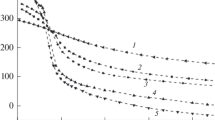Abstract
The absorption spectrum of the silver perchlorate-pyridine system was measured in acetonitrile and ethanol in the wavelength region of 180 mμ to 400 mμ. It was found that the solution exhibits a new shoulder in the 210 mμ region characteristic for the 1∶1 complex, in addition to the absorption maxima at 196 mμ and 253 mμ which correspond, respectively, to the L a and L b bands of pyridine. From the concentration dependence of the absorption intensity of this shoulder, the equilibrium constant for 1∶1 complex formation was determined to be 108 l/mole at 26 °C. Furthermore, we studied theoretically the electronic structure of this complex by the method of the localized orbital model, the effect of the solvation energy upon the charge-transfer configurations being taken into account. The theoretical results show that the new absorption band at 207.5 mμ has to considerably great extent the character of a charge-transfer type excitation.
Zusammenfassung
Das Absorptionsspektrum des Systems AgClO4-Pyridin in Acetonitril- und Äthanol-Lösung wurde im Bereich von 400-180 mμ vermessen. Es treten Absorptionsmaxima bei 196 und 253 mμ auf, die der L a -bzw. L b -Bande des Pyridins entsprechen; daneben eine Schulter bei 207 mμ als Charakteristikum des 1∶1-Ag+-Pyridin-Komplexes. Aus der Konzentrationsabhängigkeit der Intensität dieser Schulter folgt als Gleichgewichtskonstante der Komplexbildung k=108 l/Mol (26 °C), aus der Temperaturabhängigkeit ΔH=4,5 kcal/Mol, ΔS=−6 Cl in guter Übereinstimmung mit polarographischen Ergebnissen. Weiterhin wurde die Elektronenstruktur mit der Methode der Moleküle in Molekülen unter Berücksichtigung von Solvatationseinflüssen untersucht. Danach ist die neue Schulter als Ladungsübergangsbande zu klassifizieren.
Résumé
Mesure du spectre d'absorption du système AgClO4-Pyridine en milieu acétonitrile ou éthanol dans le domaine 400-180 mμ. On obtient des maxima d'absorption vers 196 et 253 mμ correspondant aux bandes L a et L b de la pyridine; un épaulement vers 207 mμ est caractéristique du complexe 1∶1-Ag+-Pyridine. D'après la variation de l'intensité de cet épaulement avec la concentration on obtient comme constante d'équilibre du complexe k=100 l/Mol (26 °C), et à partir de la variation avec le température ΔH=4,5 kCal/Mol, ΔS=−6 Cl, en bon accord avec les résultats polarographiques. De plus la structure électronique est étudée à l'aide de la méthode des molécules dans les molécules en considérant les effets de solvatation. On en déduit le caractère de bande de transfert de charge de cet épaulement.
Similar content being viewed by others
References
Mulliken, R. S.: J. Amer. chem. Soc. 74, 811 (1952).
Keefer, R. M., and L. J. Andrews: a) J. Amer. chem. Soc. 71, 3664 (1949); 72, 3113, 5034 (1950); b) 74, 640 (1952).
Lucas, H. J.: J. Amer. chem. Soc. 60, 836 (1938); 65, 227 (1943); 74, 1333, 1338 (1952).
Hosoya, H., and S. Nagakura: Bull. chem. Soc. Japan 37, 249 (1964).
Peard, W. J., and R. T. Pflaum: J. Amer. chem. Soc. 80, 1593 (1958).
Mulliken, R. S., and W. B. Person: Private communication.
Weissberger, A., and E. S. Proskauer: Technique of Organic Chemistry VII, Organic Solvents. New York: Interscience Publishers, Inc. 1935.
Tsubomura, H., K. Kimura, K. Kaya, J. Tanaka, and S. Nagakura: Bull. chem. Soc. Japan 37, 417 (1964).
Bruehlman, R. J., and F. H. Verhoek: J. Amer. chem. Soc. 70, 1401 (1948).
Dunitz, J. D.: Acta Cryst. 10, 307 (1957).
Prosen, R. J., and K. N. Trueblood: Acta Cryst. 9, 741 (1956).
Mataga, N., u. K. Nishimoto: Z. physik. Chem. N.F. 13, 140 (1957).
Watanabe, K., T. Nakayama, and L. Mottl: J. quant. Spectr. radiat. Transfer 2, 369 (1962).
Jaffe, H. H., and G. O. Doak: J. chem. Physics 21, 196 (1953).
Mulliken, R. S.: J. physic. Chem. 56, 295 (1952).
Pariser, R., and R. G. Parr: J. chem. Physics 21, 466 (1953).
Oshida, I., and D. Horiguchi: J. phys. Soc. Japan 11, 330 (1956).
Carlson, G. A., J. P. Mcreynolds, and F. H. Verhoek: J. Amer. chem. Soc. 67, 1334 (1945).
Author information
Authors and Affiliations
Rights and permissions
About this article
Cite this article
Bando, Y., Nagakura, S. The electronic structure and spectrum of the silver(I)perchlorate-pyridine complex. Theoret. Chim. Acta 9, 210–221 (1968). https://doi.org/10.1007/BF00526600
Received:
Issue Date:
DOI: https://doi.org/10.1007/BF00526600



